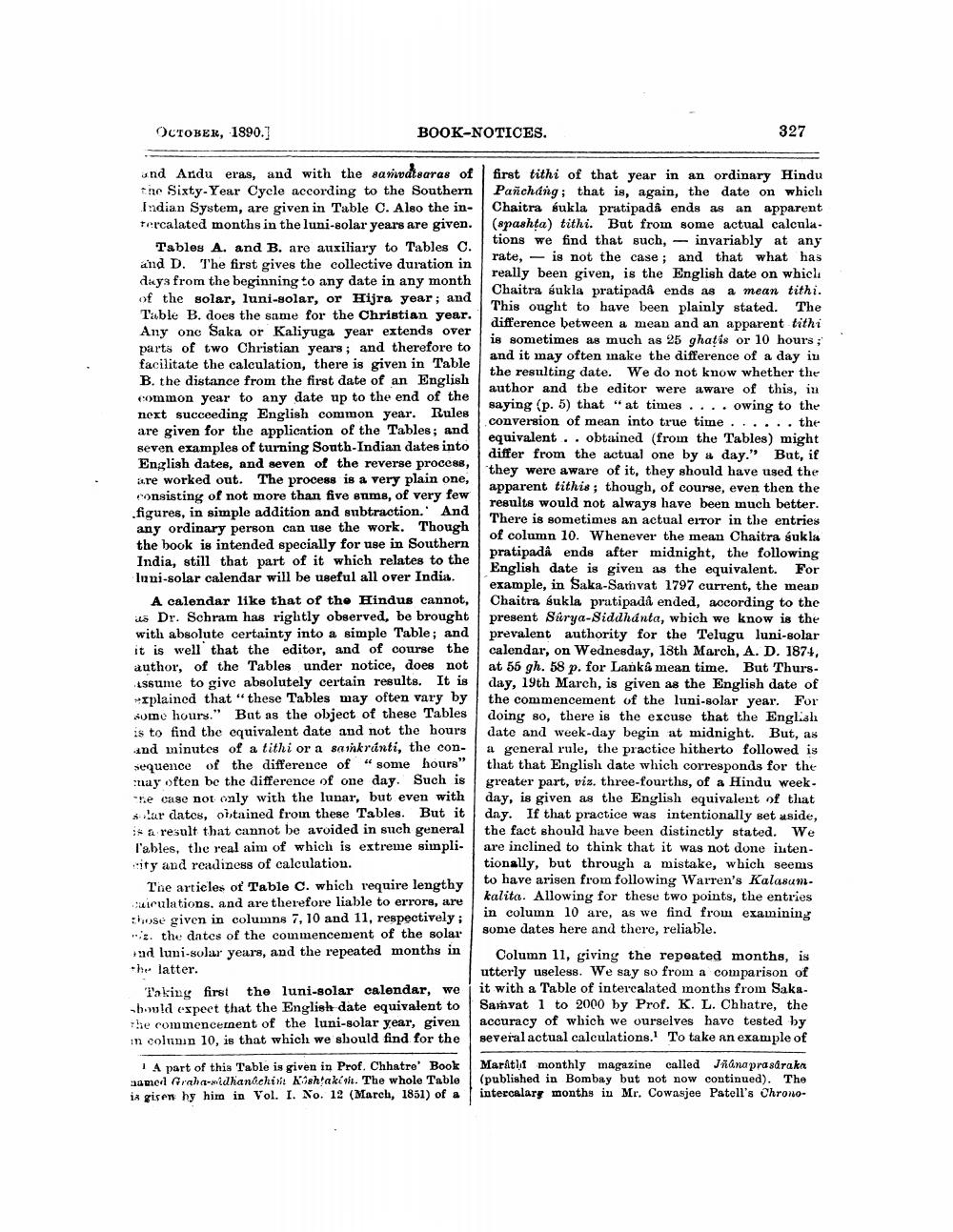________________
OCTOBER, 1890.]
BOOK-NOTICES.
327
und Andu eras, and with the sandtsaras of first tithi of that year in an ordinary Hindu the Sixty-Year Cycle according to the Southern Panchang; that is, again, the date on which Indian System, are given in Table C. Also the in- Chaitra bukla pratipada ends as an apparent tercalated months in the luni-solar years are given. (spashta) tithi. But from some actual calcula. Tables A. and B. are auxiliary to Tables C.
tions we find that such, - invariably at any and D. The first gives the collective duration in
rate, is not the case; and that what has days from the beginning to any date in any month
really been given, is the English date on which
Chaitra sukla pratipadå ends as a mean tithi. of the solar, luni-solar, or Hijra year; and Table B. does the same for the Christian year.
This ought to have been plainly stated. The
difference between a mean and an apparent tithi Any one Saka or Kaliyuga year extends over
is sometimes as much as 25 ghatis or 10 hours; parts of two Christian years; and therefore to facilitate the calculation, there is given in Table
and it may often inake the difference of a day in B. the distance from the first date of an English
the resulting date. We do not know whether the
author and the editor were aware of this, in common year to any date up to the end of the
saying (p. 5) that "at times .... owing to the next succeeding English common year. Rules
conversion of mean into true time...... the are given for the application of the Tables; and
equivalent .. obtained (from the Tables) might seven examples of turning South Indian dates into
differ from the actual one by a day." But, if English dates, and seven of the reverse procese, are worked out. The process is a very plain one,
they were aware of it, they should have used the
apparent tithis; though, of course, even then the consisting of not more than five sums, of very few
results would not always have been much better. figures, in simple addition and subtraction. And
There is sometimes an actual error in the entries any ordinary person can use the work. Though
of column 10. Whenever the mean Chaitra sukla the book is intended specially for use in Southern India, still that part of it which relates to the
pratipadå ends after midnight, the following
English date is given as the equivalent. luni-solar calendar will be useful all over India.
For
example, in Saka-Samvat 1797 current, the mean A calendar like that of the Hindus cannot, Chaitra sukla pratipadå ended, according to the its Dr. Schram has rightly observed, be brought present Sürya-Siddhanta, which we know is the with absolute certainty into a simple Table; and prevalent authority for the Telugu luni-solar it is well that the editor, and of course the calendar, on Wednesday, 18th March, A. D. 1874, author, of the Tables under notice, does not at 55 gh. 58 p. for Lanká mean time. But Thurs. 18sume to give absolutely certain results. It is
day, 19th March, is given as the English date of Iplained that "these Tables may often vary by the commencement of the luni-solar year. For somo hours." But as the object of these Tables doing so, there is the excuse that the English is to find the equivalent date and not the hours date and week-day begin at midnight. But, as and minutes of a tithi or a sankranti, the con- a general rule, the practice hitherto followed is sequence of the difference of some hours" that that English date which corresponds for the rray often be the difference of one day. Such is greater part, viz. three-fourths, of a Hindu week
he case not only with the lunar, but even with day, is given as the English equivalent of that slar dates, obtained from these Tables. But it day. If that practice was intentionally set aside,
a result that cannot be avoided in such general the fact should have been distinctly stated. We l'ables, the real aim of which is extreme simpli- are inclined to think that it was not done intenity and readiness of calculation.
tionally, but through a mistake, which seems The articles of Table C. which require lengthy
to have arisen from following Warren's Kalasumwirulations, and are therefore liable to errors, are
kalita. Allowing for these two points, the entries 50se given in columns 7,10 and 11, respectively;
in column 10 are, as we find from examining 2. the dates of the commencement of the solar
some dates here and there, reliable. ad luni-solar years, and the repeated months in
Column 11, giving the repeated months, is the latter.
utterly useless. We say so from a comparison of Taking first the luni-solar calendar, we it with a Table of intercalated months from Sakabould expect that the English date equivalent to Samvat 1 to 2000 by Prof. K. L. Chhatre, the The commencernent of the luni-solar year, given accuracy of which we ourselves have tested by in columın 10, is that which we should find for the several actual calculations. To take an example of
1 A part of this Table is given in Prof. Chhatre' Book aanoil Graha-midhanachi Kshakch. The whole Table is gisen hy him in Vol. I. No. 12 (March, 1851) of a
MaratlI monthly magazine called Jnana prasdraka (published in Bombay but not now continued). The intercalary months iu Mr. Cowasjee Patell's Chrono




